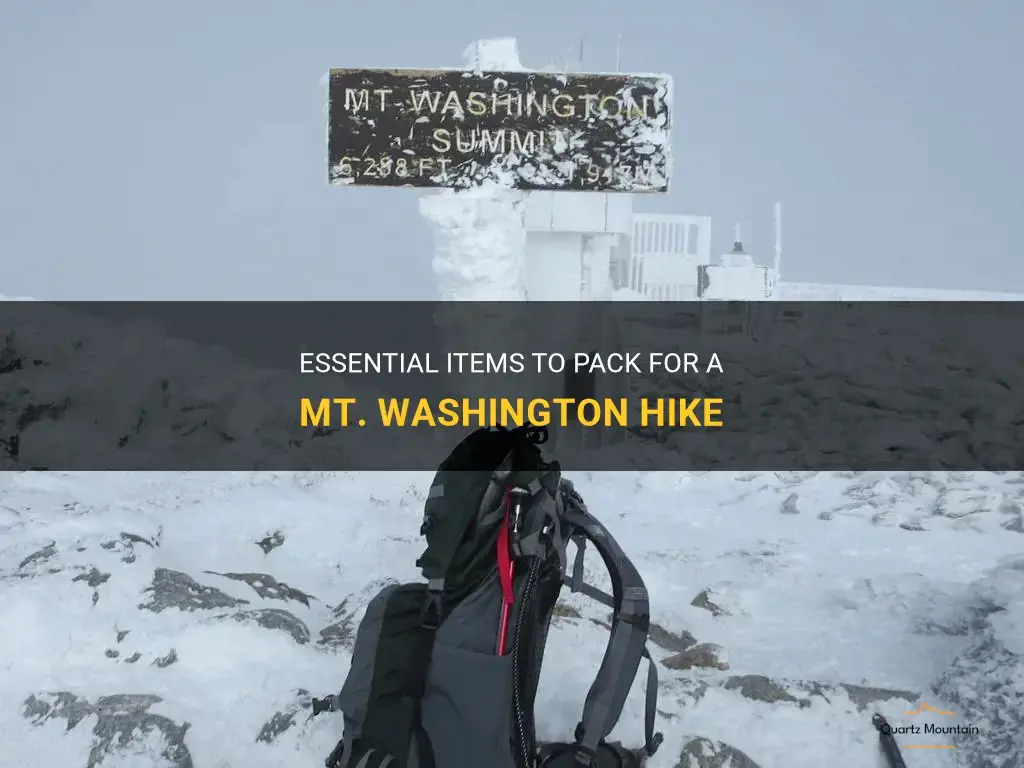
Are you planning a hike up Mt. Washington, one of the most challenging peaks in the Northeast? While the summit rewards adventurers with breathtaking views, it also presents unpredictable and often harsh weather conditions. To ensure your safety and comfort, it's crucial to pack the right essential items. In this guide, we'll outline the must-have gear for your Mt. Washington hike, from sturdy footwear to reliable navigation tools. So, whether you're a seasoned hiker or a first-timer, read on to make sure you're properly equipped for this epic mountain adventure.
What You'll Learn
- What are the essential items to pack for a hike on Mount Washington?
- Are there specific clothing items that are recommended for hiking on Mount Washington?
- What kind of footwear is best for hiking on Mount Washington?
- Are there any specific safety gear or equipment that should be included in a pack for a hike on Mount Washington?
- Are there any specific food or drink recommendations for a hike on Mount Washington?

What are the essential items to pack for a hike on Mount Washington?
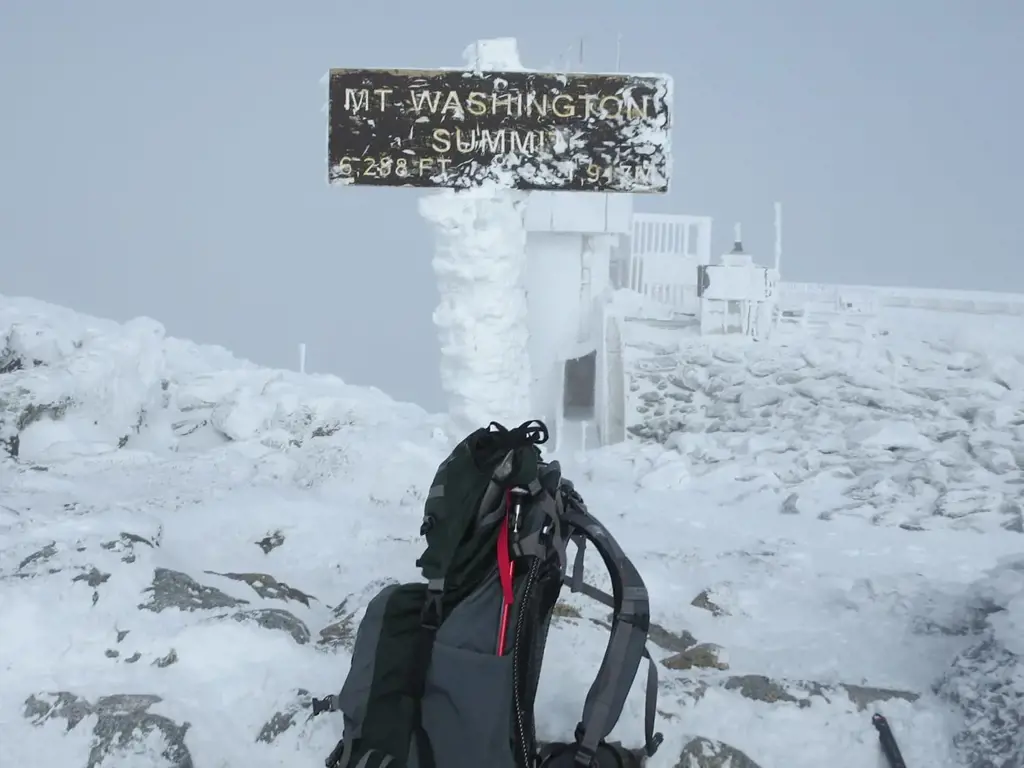
When planning a hike on Mount Washington, it is crucial to pack the right gear and essentials to ensure a safe and enjoyable experience. Mount Washington, located in New Hampshire, is notorious for its unpredictable weather conditions and challenging terrain. Whether you are a seasoned hiker or a beginner, it is important to be prepared with the following essential items.
- Clothing: Layering is key when it comes to clothing for hiking on Mount Washington. Start with a moisture-wicking base layer, which will help keep you dry and comfortable. This layer should be followed by an insulating mid-layer, such as a fleece jacket or a down vest. Finally, add a waterproof and windproof outer layer to protect you from the elements. Don't forget to pack a hat, gloves, and warm socks to keep your extremities warm.
- Footwear: Invest in a good pair of hiking boots that offer ankle support and have a sturdy sole for traction. Mount Washington's rugged terrain can be challenging, so having proper footwear is essential to prevent slips and falls. Make sure to break in your boots before your hike to avoid blisters and discomfort.
- Backpack: Choose a backpack that fits comfortably and has enough space to carry all your essentials. Look for a backpack with adjustable straps and a hip belt to distribute the weight evenly. Pack a rain cover for your backpack to protect your belongings from moisture.
- Navigation tools: Mount Washington has a network of trails, and it is crucial to have a map and compass to navigate your way. Familiarize yourself with the route before your hike, and consider bringing a GPS device or a smartphone with GPS capabilities as a backup.
- Water and food: Stay hydrated by carrying an adequate amount of water. Mount Washington's strenuous hikes will make you sweat, so it is important to replenish your fluids regularly. Pack high-energy snacks such as granola bars, nuts, and dried fruits to keep your energy levels up during the hike.
- First aid kit: Accidents can happen, even on well-prepared hikes. Pack a basic first aid kit with bandages, antiseptic wipes, pain relievers, and any personal medications you may need. It is also a good idea to carry a whistle in case you need to attract attention in an emergency.
- Sun protection: Protect yourself from the sun's harmful UV rays by wearing sunscreen, sunglasses, and a hat. The higher altitude on Mount Washington means that you are more exposed to the sun's rays, so it is important to take precautions.
- Emergency shelter: Mount Washington's weather can change rapidly, and it is important to be prepared for unexpected situations. Carry a lightweight emergency shelter such as a space blanket or a bivy sack to provide protection from the elements if needed.
- Lighting: Bring a headlamp or a flashlight with extra batteries, especially if you plan to hike during sunrise or sunset. Mount Washington's terrain can be challenging, and having a reliable light source is essential for navigating in low light conditions.
- Communication devices: In case of an emergency, it is important to have a way to communicate with others. Carry a fully charged cell phone, but keep in mind that reception may be limited in some areas. Consider bringing a portable charger or a satellite phone as a backup.
In summary, packing the right gear and essentials is crucial when planning a hike on Mount Washington. Be prepared for the unpredictable weather and challenging terrain by bringing proper clothing, footwear, navigation tools, water and food, a first aid kit, sun protection, emergency shelter, lighting, and communication devices. By being well-prepared, you can have a safe and enjoyable hiking experience on Mount Washington.
Packing Essentials: How to Pack for Any Weather
You may want to see also

Are there specific clothing items that are recommended for hiking on Mount Washington?

When hiking on Mount Washington, it is important to wear the right clothing to ensure your comfort and safety. Mount Washington is known for its unpredictable weather and challenging terrain, so it is crucial to be prepared with appropriate clothing to protect yourself from the elements. Here are some specific clothing items that are recommended for hiking on Mount Washington:
- Base Layer: Start with a moisture-wicking base layer made of synthetic materials like polyester or merino wool. This will help regulate your body temperature and keep you dry by wicking away sweat.
- Insulating Layer: On top of your base layer, wear an insulating layer such as a fleece jacket or a down sweater. This layer will provide additional warmth and help trap body heat.
- Outer Shell: An outer shell, like a waterproof and windproof jacket, is essential for hiking on Mount Washington. Look for jackets made with Gore-Tex or a similar breathable and waterproof fabric. This will protect you from rain, snow, and strong winds.
- Pants: Choose pants made of quick-drying and durable materials like nylon or a synthetic blend. Avoid cotton as it holds moisture and can make you cold and uncomfortable. Consider wearing convertible pants that can be zipped off into shorts if the weather permits.
- Hiking Boots: Invest in a pair of sturdy and waterproof hiking boots with good ankle support. Mount Washington has rocky and uneven terrain, so having proper footwear is crucial to prevent sprains or injuries.
- Socks: Wear moisture-wicking socks made of merino wool or synthetic materials. Avoid cotton socks as they can retain moisture and lead to blisters. Consider wearing liner socks underneath for added comfort and to prevent friction.
- Hat and Gloves: Protect your extremities by wearing a warm hat and gloves. Opt for gloves that are waterproof, windproof, and insulated. A hat that covers your ears will keep you warm in cold temperatures and protect you from wind chill.
- Sunglasses: Mount Washington is known for its stunning views, but the sun's glare can be intense. Wear sunglasses with UV protection to shield your eyes from harmful rays. Polarized lenses can also help reduce glare and improve visibility.
- Backpack: Choose a backpack with a capacity that can hold all your essentials, including extra clothing layers, food, water, and emergency equipment. Look for a backpack with padded shoulder straps and a waist belt for added comfort during your hike.
Remember that temperatures and weather conditions can change rapidly on Mount Washington, so it is important to dress in layers that you can easily add or remove as needed. Additionally, always check the weather forecast and trail conditions before heading out, and make sure to pack extra clothing in case of emergencies or unexpected weather changes. By wearing the right clothing and being prepared, your hike on Mount Washington will be much more enjoyable and safe.
Essential Items to Pack for Your Trip to Baños Ecuador
You may want to see also

What kind of footwear is best for hiking on Mount Washington?
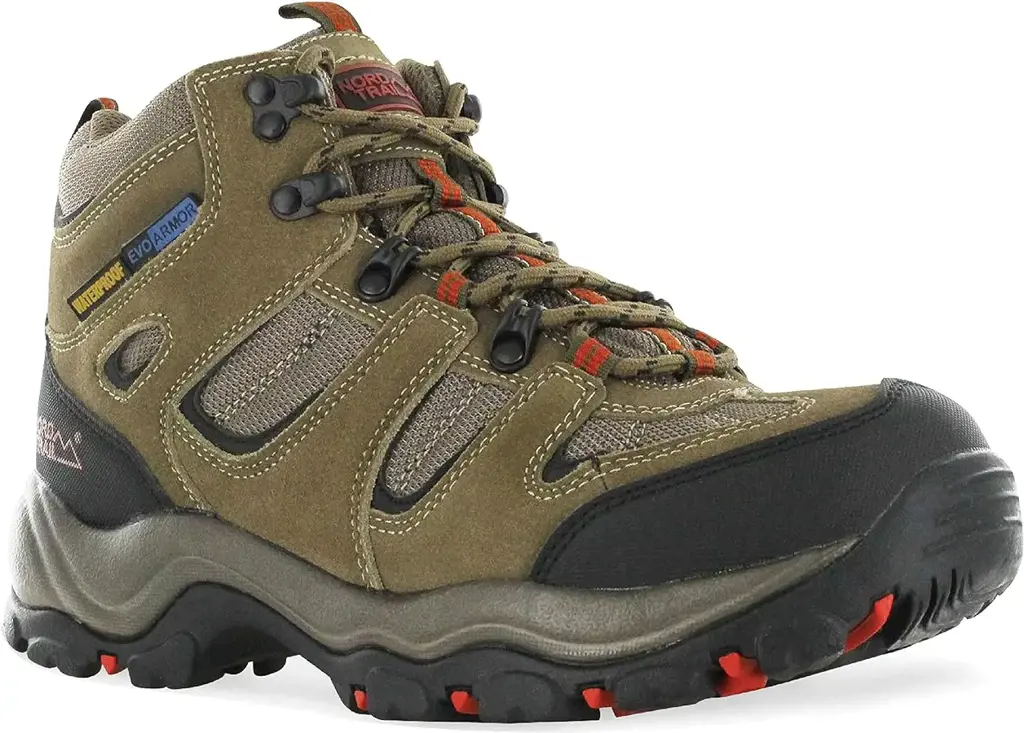
When planning a hiking trip to Mount Washington, one of the most important considerations is choosing the right footwear. Mount Washington is known for its challenging and ever-changing weather conditions, rough terrain, and steep slopes. Therefore, it is crucial to have appropriate footwear that provides stability, protection, comfort, and traction.
Hiking boots are generally recommended for hiking on Mount Washington. These boots are designed specifically for outdoor activities like hiking and provide the necessary support and protection for your feet and ankles. Here are a few key features to look for in hiking boots for Mount Washington:
- Sturdy Construction: Look for boots with a solid construction, reinforced toe and heel areas, and durable materials. It is important for them to withstand rough terrains, rocks, and uneven surfaces.
- Waterproof and Breathable: Mount Washington is notorious for its unpredictable weather. Having waterproof boots is essential to keep your feet dry and comfortable. Look for boots with a waterproof membrane, such as Gore-Tex, that will prevent water from seeping into the boots. Additionally, breathable materials will help to wick away sweat and moisture, keeping your feet dry and preventing blisters.
- Ankle Support: Since the terrain on Mount Washington can be steep and rocky, ankle support is crucial to prevent twisted or sprained ankles. Look for boots with a higher ankle collar and sturdy lacing system that provides stability and prevents your ankles from rolling.
- Traction: With various terrains and weather conditions, you need boots that provide excellent traction. Look for boots with aggressive lugs or a Vibram outsole that will provide a solid grip on wet rocks, loose gravel, and slippery terrain.
In addition to hiking boots, it is important to wear appropriate socks that provide cushioning, moisture-wicking, and blister prevention. Merino wool or synthetic socks are great options as they offer these features and help regulate temperature.
It's also essential to break in your hiking boots before tackling Mount Washington. Start wearing them on shorter hikes or daily walks to allow your feet to adjust and the boots to mold to your feet's shape. This will help prevent blisters and discomfort during your Mount Washington hike.
Overall, investing in a good pair of hiking boots that meet the specific requirements of Mount Washington is crucial for a safe and enjoyable hiking experience. Remember, everyone's feet are different, so try on different boots, walk around in them, and choose the ones that fit you comfortably and provide the necessary features for the challenging terrain of Mount Washington.
Essential Gear for a Day Hike in the UK: What to Pack
You may want to see also

Are there any specific safety gear or equipment that should be included in a pack for a hike on Mount Washington?
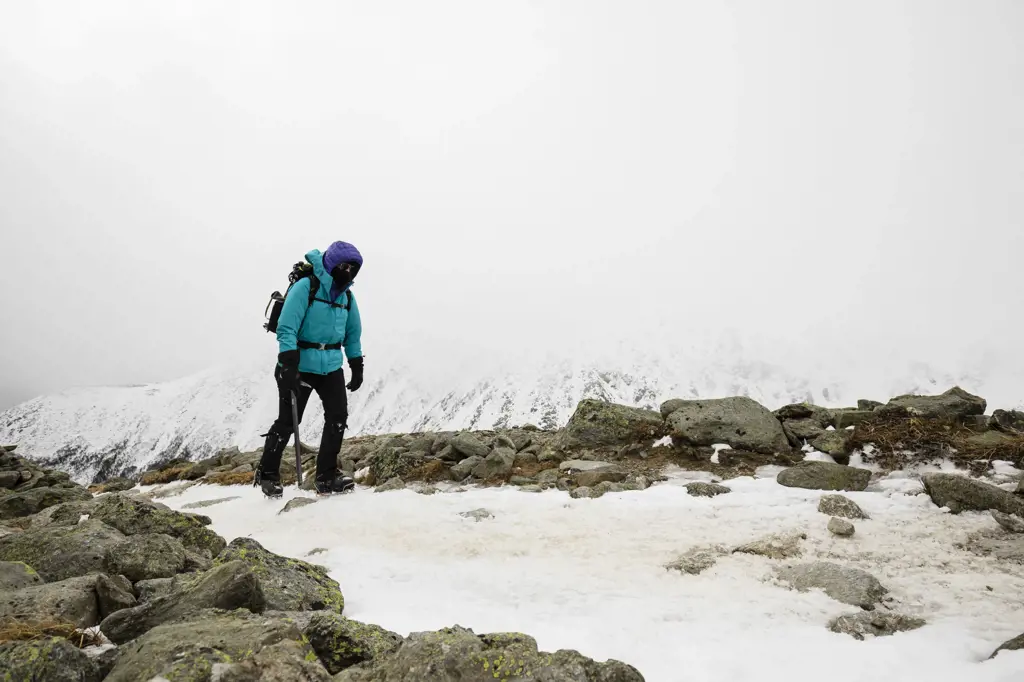
Hiking on Mount Washington, located in New Hampshire, can be a challenging and potentially dangerous endeavor. The mountain is notorious for its rapidly changing weather conditions, which can include high winds, extreme cold, and heavy precipitation. As a result, it is crucial to be prepared with the right safety gear and equipment when embarking on a hike on Mount Washington.
One of the most important pieces of safety gear to have when hiking on Mount Washington is a proper pair of hiking boots. These boots should provide excellent traction and ankle support to help prevent sprains or other injuries while navigating rocky and uneven terrain. Additionally, it is imperative to wear appropriate clothing for the hike. This typically includes moisture-wicking layers, such as a base layer, mid-layer, and outer shell, to keep you dry and regulate body temperature. It is also advisable to bring extra layers, such as a warm hat, gloves, and a down jacket, in case of sudden weather changes.
Another essential piece of equipment for hiking on Mount Washington is a reliable navigation tool, such as a map and compass or a GPS device. The trails on the mountain can be challenging to follow, especially in areas where the weather may obscure trail markers. Having a navigation tool will help ensure that you stay on track and can find your way back to safety if needed.
In addition to navigation gear, it is vital to carry a first aid kit and know how to use it. Mount Washington's rugged terrain can pose risks for injuries, such as cuts and sprains. Having a well-stocked first aid kit will allow you to treat minor injuries promptly and prevent them from escalating into more severe issues.
Other essential safety gear to include in your pack for a hike on Mount Washington includes a headlamp or flashlight, extra food and water, a whistle for emergency signaling, and a multi-tool or pocket knife. These items can be valuable in various situations, such as when hiking in low light conditions, dealing with unexpected delays, or needing to make necessary repairs to equipment.
Lastly, it is critical to check the weather forecast before heading out on a hike and adjust your plans accordingly. Mount Washington's weather can change rapidly, and it is essential to be aware of any potential storms or extreme conditions that may develop throughout the day. Having this information will allow you to make informed decisions about whether it is safe to proceed with your hike or if it would be better to reschedule.
To summarize, when preparing for a hike on Mount Washington, it is crucial to have the right safety gear and equipment. This includes proper hiking boots, appropriate clothing, navigation tools, a first aid kit, essential tools, and extra food and water. Additionally, staying informed about the weather forecast and adjusting your plans accordingly is essential for a safe and enjoyable hike on Mount Washington. By being adequately prepared, you can help mitigate risks and increase your chances of having a successful and safe hiking experience on this challenging and breathtaking mountain.
The Essential Packing Checklist for Your Next Event
You may want to see also

Are there any specific food or drink recommendations for a hike on Mount Washington?
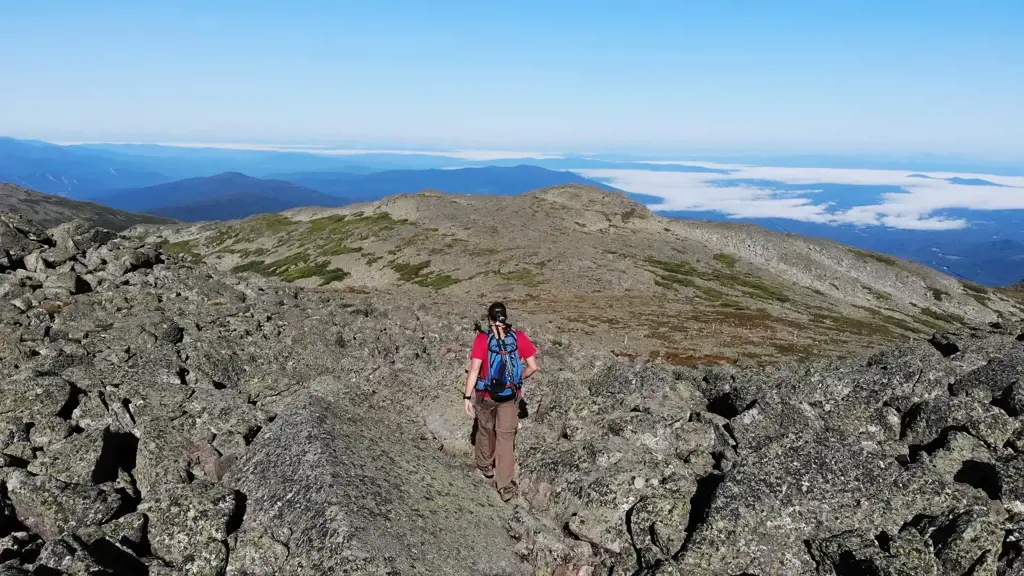
When preparing for a hike on Mount Washington, it is crucial to consider the food and drink you will bring along. This challenging mountain hike requires a high level of physical exertion, making proper nutrition and hydration essential for a successful and enjoyable experience. In this article, we will discuss some specific food and drink recommendations for a hike on Mount Washington, taking into account the unique challenges and conditions of this mountain.
Hydration is Key:
Staying hydrated is crucial during any hike, but it is especially important on Mount Washington. The combination of high altitude and strenuous activity can lead to increased fluid loss through sweat. It is recommended to drink at least 2-3 liters of water during the hike. Consider using a hydration pack or carrying multiple water bottles to ensure you have enough water to last throughout the hike.
Electrolyte Replacement:
During a long hike, you may lose significant amounts of electrolytes through sweat. These electrolytes, including sodium, potassium, and magnesium, are essential for proper muscle function. While water alone can help hydrate you, it may not replenish these electrolytes adequately. Consider bringing electrolyte replacement tablets or sports drinks to maintain electrolyte balance during your hike.
Pack Nutrient-Dense Foods:
Choose lightweight, nutrient-dense foods that provide sustained energy for the duration of your hike. Some suitable options include trail mix, energy bars, jerky, and dried fruits. These foods are easy to carry, do not require refrigeration, and provide a good balance of carbohydrates, protein, and healthy fats.
Carbohydrates for Energy:
During a challenging hike on Mount Washington, your body will rely heavily on carbohydrates for fuel. Packing foods that are high in carbohydrates, such as granola bars, whole-grain crackers, or energy gels can provide a quick source of energy to keep you going. Avoid foods that are heavy in fats or protein, as these can be harder to digest and may slow you down.
Consider High Altitude Challenges:
Mount Washington is known for its high altitude and harsh weather conditions. At higher altitudes, your body needs more energy to function, so it is important to bring foods that provide sustained energy. High altitude can also affect your appetite, so pack foods that you enjoy and are likely to eat, even if you don't have a big appetite.
Plan for Breaks:
During a long hike, it is important to take regular breaks to rest and refuel. Plan accordingly and bring foods that are easy to eat on the go, such as energy bars or bite-sized snacks. This will help you maintain energy levels and prevent bonking during the hike.
In conclusion, when preparing for a hike on Mount Washington, it is essential to plan your food and drink carefully. Staying hydrated, maintaining electrolyte balance, and packing lightweight, nutrient-dense foods are key considerations. Additionally, understanding the challenges of high altitude and harsh weather conditions can help you choose foods that will provide sustained energy and keep you nourished throughout your hike. By following these recommendations, you can ensure a safe and enjoyable hiking experience on Mount Washington.
Essential Items to Pack for Your Trip to Fiji
You may want to see also
Frequently asked questions
When preparing for a hike on Mount Washington, it is important to pack the appropriate gear and clothing. Some essentials include a sturdy backpack, a map and compass, plenty of water, high-energy snacks, a first aid kit, a headlamp, and sunscreen.
Yes, it is crucial to bring proper clothing for a hike on Mount Washington, as the weather can change dramatically and quickly. It is recommended to dress in layers, wearing moisture-wicking and insulating materials. A waterproof and windproof jacket and pants are also essential, as well as a hat and gloves to protect yourself from the cold and wind.
Yes, hiking boots are highly recommended for a hike on Mount Washington. The terrain can be rough and unpredictable, and sturdy footwear with good traction is essential for safety and comfort. It is important to break in your hiking boots before the hike to avoid blisters and discomfort.
When planning your food for a hike on Mount Washington, opt for lightweight, high-energy snacks such as trail mix, protein bars, and dried fruit. It is also important to bring a substantial lunch or meal, such as sandwiches, to keep you fueled for the hike. Don't forget to bring enough food for the duration of your hike, and pack additional snacks in case of any unexpected delays.
Yes, it is crucial to bring a map and compass when hiking Mount Washington, as the terrain can be challenging and it is easy to get disoriented. While technology such as GPS devices or smartphone apps can be helpful, they should not be relied upon as the sole navigation tools. Be sure to familiarize yourself with the map and compass before the hike and know how to use them effectively.







